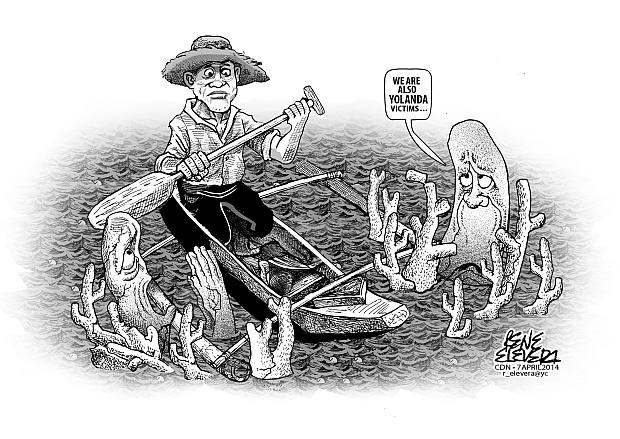
Under the sea, a still unmeasured devastation in coral reefs tells us that a second look is needed to calibrate the task of recovery ahead.
A decline in fish catch is the expected consequence of damage to the heart of a marine ecosystem.
A rapid assessment of three islets in Bantayan group of islands, where the supertyphoon made landfall in Cebu’s richest fishing grounds, was made in February, three months after the monster storm.
The study by Dr. Angel Alcala, the multi-awarded biologist from Silliman University, gave the first scientific glimpse of the undersea toll of Yolanda and had disturbing findings which he shared in a forum last Friday.
Intense waves smashed coral reefs, damaging the habitat and nurseries of the rich variety of fish and marine life in islets of Ocoy, Sillon and Hilantagaan. Fish catch dropped dramatically.
Researchers compared two kinds of sites — marine sanctuaries and fishing areas outside these protected zones, comparing data in 2012 and a post-Yolanda scan.
In marine sanctuaries, where fishing is already restricted, there was a 20 percent to 60 percent decline in fish biomass or the total volume of fish and marine life.
His conclusion was no less disturbing: “There is a need to provide alternative livelihood programs to reduce fishing pressure which delays the recovery of reefs,” he said.
In other words, people have to give the reefs a rest and lay off fishing if the reefs are to grow back and produce the volume of fish and aquatic life of pre-Yolanda levels.
Stop or reduce fishing? That’s tough medicine for coastal communities trying to get back on their feet after a disaster.
How do you tell Yolanda survivors they can’t rely on the sea for their livelihood for the next 5 to 10 years?
This is where local governments and grassroots leaders will have to make hard decisions to address a scenario of food scarcity— and prepare for that reality.
Two private foundations, alerted by reports of fish catch decline, have suspended plans to finance new fishing boats in Eastern Visayas and Bantayan, Cebu.
Humanitarian groups earlier rushed to replace bancas damaged in the storm, only to find out that in some areas, an oversupply of boats was causing a new problem of over-fishing in municipal waters.
With coral reefs in bad shape, the response has to apply to conditions on land and under the sea.
Do we spend for more boats and fishing gear, or do we find new ways for a coastal community to engage in sustainable fishing and new kinds of earning a living?
Rehabilitation plans will have to reckon with the fact that the seas of Bantayan no longer produce a bountiful harvest – for now.
Some interventions, while well meaning, may be doing more harm than good in coastal communities.
To “build back better” after Yolanda, recovery has to be a well-thought response based on the right understanding of what are needs to be answered now while not sacrificing the needs of future generations.
Disclaimer: The comments uploaded on this site do not necessarily represent or reflect the views of management and owner of Cebudailynews. We reserve the right to exclude comments that we deem to be inconsistent with our editorial standards.
